
Gullfoss Waterfall Travel Guide
Gullfoss, which translates to the "Golden Falls," is one of Iceland’s most iconic and beloved waterfalls. It's part of the popular Golden Circle route and is found in the Hvita river canyon in Southwest Iceland.
Gullfoss waterfall is one of Iceland's most iconic natural attractions, located in the Golden Circle route on the South Coast, approximately 1.5 hours from Reykjavik. As part of the popular Golden Circle route, Gullfoss is usually paired with visits to the Geysir geothermal area and Thingvellir National Park.
The name Gullfoss means "Golden Falls," and it's known for its powerful cascade. Gullfoss is fed by the Hvita River and plunges into a dramatic canyon, creating two distinct drops that total around 105 feet (32 meters) in height.
Gullfoss holds significant cultural and environmental importance for Iceland. It was almost harnessed for hydroelectric power in the early 20th century, but thanks to the efforts of Sigríður Tómasdóttir, a local farmer’s daughter who campaigned to protect it, the plans were eventually abandoned. Today, Gullfoss is a protected natural site and a symbol of Iceland's commitment to conservation.
Visitors to Gullfoss can easily include it in self-drive tours of the Golden Circle, exploring freely with a rental car, but you can easily visit with Golden Circle tours from Reykjavik. If you'd like to fully enjoy all that Iceland's Golden Circle area offers, you can book accommodation in the Golden Circle and stay close to all the major attractions.
About the Gullfoss Waterfall
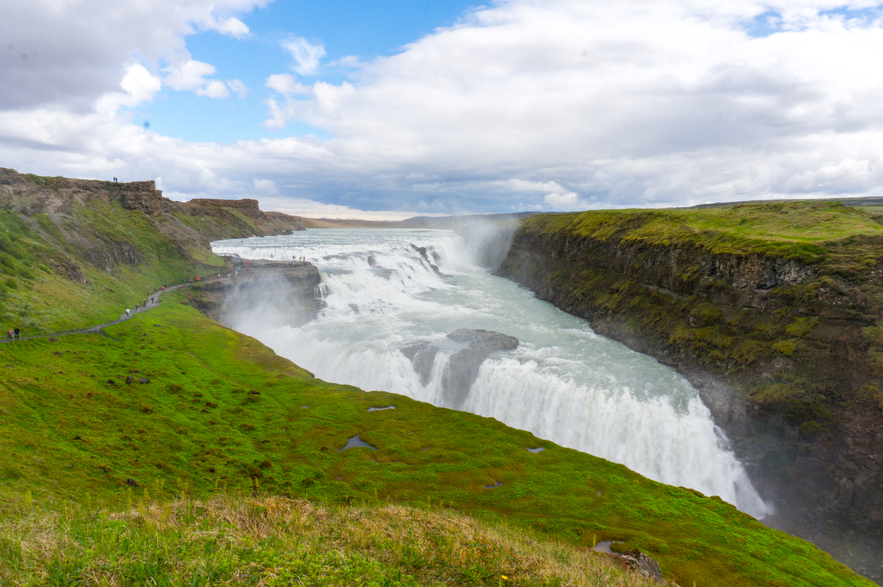 The Hvítá River originates from the Langjökull glacier, flowing through Iceland’s rugged landscape before dramatically plunging over the two-tiered Gullfoss waterfall. Rather than being a single cascade, Gullfoss is made up of two distinct stages: the first drop is 36 feet (11 meters), followed by a second, larger plunge of 69 feet (21 meters). Together, these stages create an incredible display of nature’s power.
The Hvítá River originates from the Langjökull glacier, flowing through Iceland’s rugged landscape before dramatically plunging over the two-tiered Gullfoss waterfall. Rather than being a single cascade, Gullfoss is made up of two distinct stages: the first drop is 36 feet (11 meters), followed by a second, larger plunge of 69 feet (21 meters). Together, these stages create an incredible display of nature’s power.
Flanked by towering canyon walls that reach up to 230 feet (70 meters) high, Gullfoss plunges into the majestic Gullfossgjufur canyon. This deep ravine, geologists believe, was formed by violent glacial floods during the end of the last ice age. In the summer, around 4,943 cubic feet (140 cubic meters) of water rushes over the falls per second, while in winter, this flow reduces to about 3,849 cubic feet (109 cubic meters), still maintaining an impressive force.
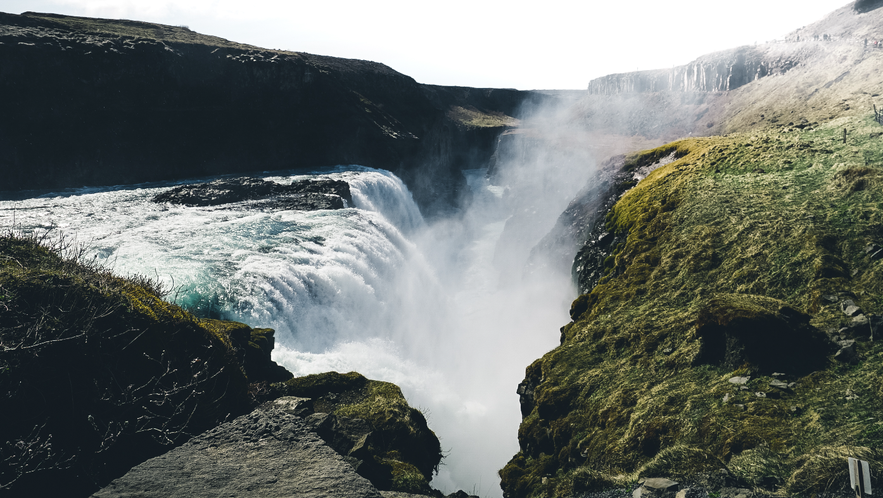 With such energy, don't be surprised if you find yourself drenched by the waterfall’s mighty spray if you get too close! If you want to add to the adventure of your visit, the nearby Langjokull glacier offers opportunities for snowmobile tours along its gleaming surface, adding a thrilling element to a Golden Circle tour.
With such energy, don't be surprised if you find yourself drenched by the waterfall’s mighty spray if you get too close! If you want to add to the adventure of your visit, the nearby Langjokull glacier offers opportunities for snowmobile tours along its gleaming surface, adding a thrilling element to a Golden Circle tour.
History of the Gullfoss Waterfall
 In the early 20th century, Gullfoss was at the center of a controversy regarding foreign investors and their desire to profit off Iceland’s nature. In 1907, an English businessman, Howell, sought to utilize the waterfall’s energy and harbored ambitions to use its energy to fuel a hydroelectric plant.
In the early 20th century, Gullfoss was at the center of a controversy regarding foreign investors and their desire to profit off Iceland’s nature. In 1907, an English businessman, Howell, sought to utilize the waterfall’s energy and harbored ambitions to use its energy to fuel a hydroelectric plant.
At the time, Gullfoss was owned by a farmer named Tómas Tómasson. Tómas declined Howell's offer to purchase the land, stating famously, “I will not sell my friend!” He would, however, go on to lease Howell the land without knowing of a loophole that would allow Howell to proceed with his plans.
It was Tómas’ daughter, Sigríður Tómasdóttir, who would lead the charge to stop Howell’s ambitions. Having grown up on her father’s sheep farm, Brattholt, where she helped pave the first road to Gullfoss, she sought to get the contract nullified, hurriedly saving her own money to hire a lawyer.
The ensuing legal battle was an uphill struggle; the case continued for years, forcing Sigríður to travel many times by foot to Reykjavík, a distance of over 100 kilometers (62 miles). Circumstances became so difficult that Sigríður threatened to throw herself into the waterfall if any construction began.
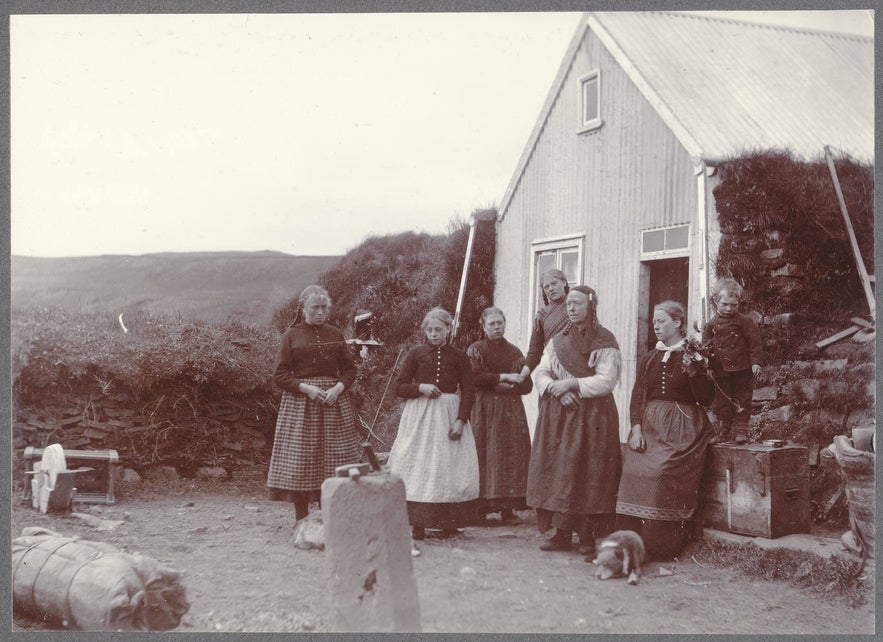
Photo from Wikimedia, Creative Commons, from Cornell University Library. Sigríður Tómasdóttir and her family at the Brattholt farm around the year 1900.
Her tenacity, however, resulted in success. In 1929, Howell withdrew from the lease, unable to keep up with the costs and difficulties of his plan. The waterfall thus fell back into the hands of the Icelandic people.
Today, Sigríður is recognized for her perseverance in protecting Gullfoss and is often hailed as Iceland’s first environmentalist. As such, she is one of the most famous figures in Iceland’s history. Her contribution is forever marked in stone; a plaque detailing her plight sits at the top of Gullfoss.
Interestingly, the lawyer who assisted Sigríður, Sveinn Björnsson, went on to go down in history too, as he later became the first president of an independent Iceland in 1944.
The Gullfoss Visitor Center
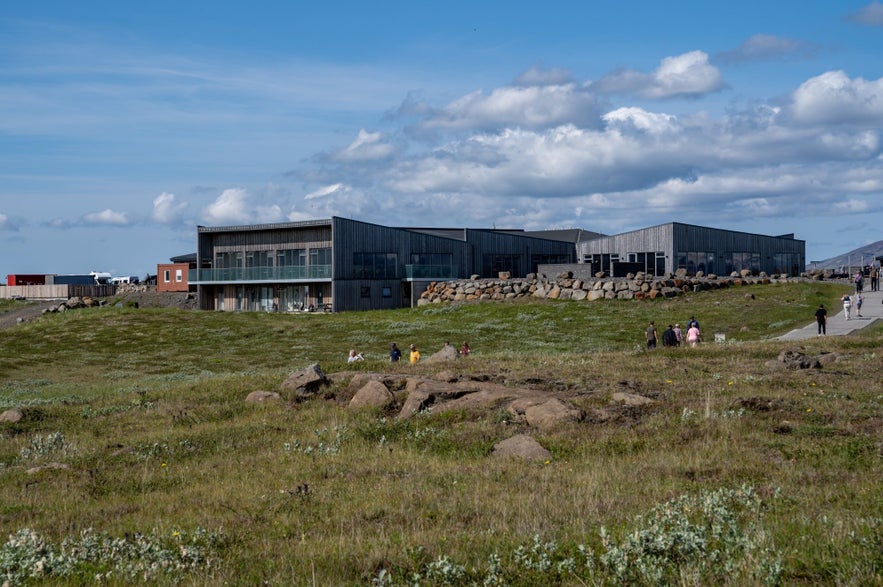 The main amenities by the Gullfoss waterfall are in the Gullfoss Visitor Center, where you can enjoy a meal at the locally run Gullfoss Café. The café offers a variety of refreshments, including hot soups, sandwiches, salads, and cakes. It's a perfect spot to relax when visiting the waterfall.
The main amenities by the Gullfoss waterfall are in the Gullfoss Visitor Center, where you can enjoy a meal at the locally run Gullfoss Café. The café offers a variety of refreshments, including hot soups, sandwiches, salads, and cakes. It's a perfect spot to relax when visiting the waterfall.
The visitor center also features a shop with fun Icelandic souvenirs, such as handmade wool items and local crafts. It's a great place to pick up gifts or keepsakes to remember your trip.
Accommodation Near the Gullfoss Waterfall
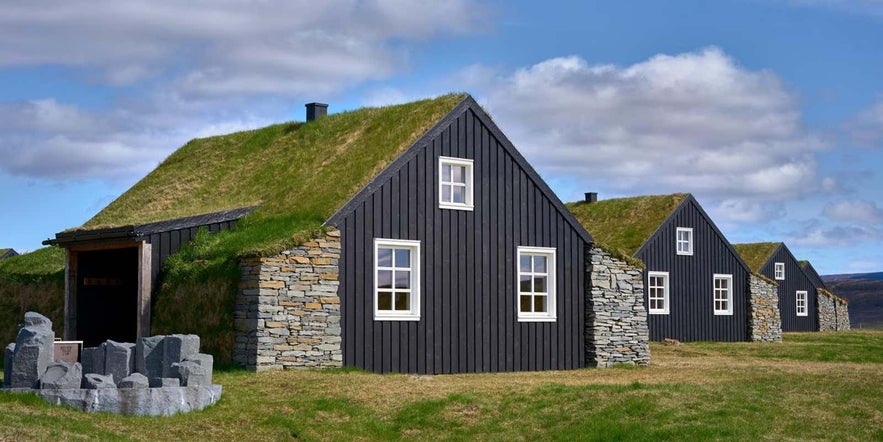
Photo from Torfhús Retreat
If you want to stay near the Gullfoss waterfall, there are several excellent Iceland accommodations that offer convenient access to the Golden Circle and the stunning natural beauty of the area.
The closest option is the 3-star Hotel Gullfoss, which offers comfortable rooms just a short drive from the waterfall. For a luxurious experience, you can opt for Hotel Geysir, a 4-star accommodation located around a 10-minute drive from Gullfoss.
One of the more unique accommodations in Iceland is the Torfhús Retreat, a 4-star hotel that's just a 16-minute drive from the Gullfoss waterfall. It's inspired by traditional Icelandic turf houses and the country's early Viking history.
For those looking for a more homey stay, the Efstidalur Farm Hotel is part of a working farm, complete with cozy rooms, a great restaurant, and some of the best ice cream in Iceland!
FAQs about Gullfoss waterfall
Here are some frequently asked questions about the Gullfoss waterfall.
What is Gullfoss?
Gullfoss, also known as the "Golden Waterfall," is one of Iceland's most popular and iconic waterfalls. It is located in the southwest of the country, along the Golden Circle tourist route.
How tall is Gullfoss?
Gullfoss has two drops, one measuring 36 feet (11 meters) and the other 69 feet (21 meters), for a total height of 105 feet (32 meters).
How was Gullfoss formed?
Gullfoss was formed during the last ice age, when glacial runoff carved out a deep canyon in the Hvita river. The waterfall is created by a series of cascades and drops that plunge into the canyon below.
Can you walk around Gullfoss?
Yes, there are several walking paths and viewing platforms around Gullfoss that offer stunning views of the waterfall and canyon. Visitors should be careful and stay on designated paths, as the terrain can be slippery and dangerous.
Can you visit Gullfoss year-round?
Yes, Gullfoss is open to visitors year-round. However, the best time to visit is during the summer months (June-August), when the weather is milder and the days are longer. During the winter months (December-February), the waterfall can be partially frozen and covered in snow, creating a beautiful winter wonderland scene.
Is there an entrance fee for Gullfoss?
No, but there is a parking fee at the Gullfoss visitor center, which is used to maintain the area and facilities. Visitors can pay the fee at a self-service machine in the parking lot. If you are visiting on a guided tour, then the parking fee is included.
What are some other attractions near Gullfoss?
Gullfoss is located along the Golden Circle tourist route, which includes several other popular attractions, including the Geysir geothermal area, Thingvellir National Park, and the Kerid volcanic crater.
Attractions Nearby
Popular categories

Download Iceland’s biggest travel marketplace to your phone to manage your entire trip in one place
Scan this QR code with your phone camera and press the link that appears to add Iceland’s biggest travel marketplace into your pocket. Enter your phone number or email address to receive an SMS or email with the download link.


















